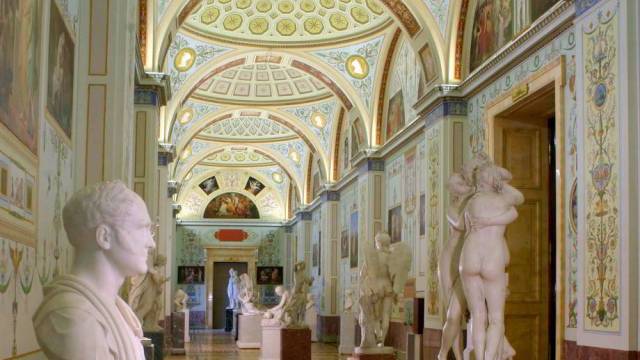
 When making Hermitage Revealed, director Margy Kinmonth had almost unrestricted access to areas of the Hermitage Museum that are a complete mystery to the public, and as such one can imagine both how exciting and stressful the situation must’ve been for the filmmaker. Perhaps, at first she was struck by the eternal dilemma faced by any mortal upon entering one of the world’s great museums: what are the pieces I can’t leave without seeing? As she gave her film form, she must’ve put on the hat of an assertive tour guide who takes you where you need to be. Needless to mention, she must’ve at one point contemplated the question of why to make a film about art to begin with.
When making Hermitage Revealed, director Margy Kinmonth had almost unrestricted access to areas of the Hermitage Museum that are a complete mystery to the public, and as such one can imagine both how exciting and stressful the situation must’ve been for the filmmaker. Perhaps, at first she was struck by the eternal dilemma faced by any mortal upon entering one of the world’s great museums: what are the pieces I can’t leave without seeing? As she gave her film form, she must’ve put on the hat of an assertive tour guide who takes you where you need to be. Needless to mention, she must’ve at one point contemplated the question of why to make a film about art to begin with.
From a practical perspective, the answer to the last question is rather simple: the Hermitage is celebrating its 250th anniversary and a film was commissioned to celebrate its undeniable legacy. From a more philosophical perspective though, the film leaves something to be desired, as it fails to bring up larger questions about the importance of art in society. Kinmonth takes us on a chronological tour of the museum’s history, going back all the way to the times of its creator Catherine the Great, up to the violent times following the October revolution which led to the sale of more than two thousand pieces to American institutions in order to support the Communist system, which was in serious need of cash flow.
While Hermitage Revealed works efficiently, it can’t help but be cursed with the very same element of dissatisfaction that follows almost any great museum visit, we are left craving more, perhaps every single person sitting in the audience will wish at some point to give a turn opposite to what Kinmonth’s camera does. There is a sense of endless discovery that the documentary, with its television-style aesthetics, can’t help but limit. We understand why the film takes the course it does, but we are still left wondering why. The film is handsomely produced, beautifully narrated and yet it feels too reverential, too in control. It might’ve been more benefitted from a more playful approach, similar to what Frederick Wiseman did in his stunning National Gallery, which plays out like a visit to wonderland, where each door presents us with a new mystery we’re dying to solve. The Hermitage revealed in this documentary is too textbook-like for us to want to revisit it.